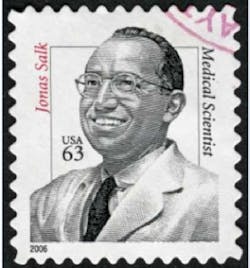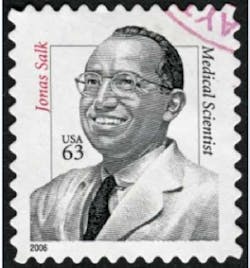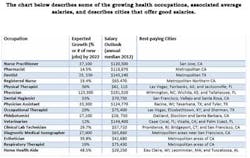More jobs; Up in smoke; Toxic beverages; Beyond the Boundaries
Jonas Salk, MD, founder of the polio vaccine, would have been 100 years old on October 28. Two years before he introduced the vaccine for polio, he published a paper entitled, “Importance of Antigenic Composition of Influenza Virus Vaccine in Protecting against the Natural Disease: Observations during the Winter of 1947-1948.”(1) This was the start of his contributions, as two years later he announced the creation of the Salk vaccine for polio. This disease was rampant from 1951 to 1954, and caused approximately 2,000 deaths per year. That was a pivotal time in public health, as the Salk polio vaccine was deemed safe and effective in 1955. On a personal note, I lost two uncles to polio in the 1920s, and have an aunt who has suffered from the effects of polio her whole life.
The average annual death toll from influenza between 1976 and 2007 was more than 23,000. Influenza is killing more young and middle-aged adults this year than usual, in part because they’re less likely to be vaccinated. The flu vaccine has a 61% effectiveness rate, according to the CDC. For more information about the seasonal flu vaccine, visit the CDC website.(2)
I attended The National Center for Dental Hygiene Research and Practice (NCDHRP) meeting “Beyond the Boundaries: Discovery, Innovation and Transformation” in Bethesda, Maryland, October 16-19. The meeting was well attended and informative, and you can read more about it in this newsletter. The proceedings of this meeting will be available in February 2015 in an open access issue of the Journal of Dental Hygiene.
I have also written about beverages in this issue. There are some ballot measures in the western part of the country regarding soft drinks. A City of San Francisco Sugary Drink Tax, Proposition E ballot measure was on the November 4 ballot, and it was rejected. A similar measure was also on the ballot in Berkeley, where it was passed by Berkeley voters. The measure in San Francisco would have imposed a 2-cent per ounce tax on sugary beverages, and was introduced by city supervisor Scott Wiener. The tax would amount to a 24-cent tax on every can of soda sold. The tax was estimated to bring in revenue of about $31 million per year.
If you are drinking diet drinks in order to lose weight, think again. An epidemiological study unexpectedly shows that the more diet sodas a person drinks, the greater the chance that he or she will become overweight or obese.(6) A later study confirmed this by looking at waist circumference (WC). WC is generally used as an indirect means of measuring visceral adiposity, a major risk factor for diabetes, cardiovascular disease, cancer, and other chronic conditions. The results of the 2011 study propose that ingesting diet soft drinks may have unintended harmful effects. Data from this and other prospective studies suggest that the promotion of diet sodas as healthy alternatives may be ill advised; they may be free of calories, but not of consequences. Among frequent users, those drinking more than two diet sodas per day had mean increases in waist circumference that were five times greater than those in non-users!(7)
Now for some good news on the job front. In “The surge in U.S. healthcare jobs: Looking ahead to 2022,” it was stated that so far in 2014, the United States has added nearly 1.6 million jobs.(8) It is predicted that from now until 2022, employment is expected to grow by more than 15 million jobs, or 11%, due to America's changing demographics. The end of the baby boomer era is upon us, and many boomers will soon be retiring from the workforce.
The third Thursday of November each year is set aside as the Great American Smokeout. Its aim is to encourage smokers to use the date to make a plan to quit, or to plan in advance and quit smoking that day. See the article in this issue of Focus for more information.
Sincerely,
References
1. Salk JE, Suriano PC. Importance of Antigenic Composition of Influenza Virus Vaccine in Protecting against the Natural Disease. Observations during the Winter of 1947-1948. American Journal of Public Health and the Nations Health 1949 39, 3, 345-355. Presented before the Epidemiology Section of the American Public Health Association at the Seventy-sixth Annual Meeting in Boston, Mass., November 9, 1948. http://ajph.aphapublications.org/doi/abs/10.2105/AJPH.39.3.345.
2. http://www.cdc.gov/flu/protect/keyfacts.html.
3. Ehlen LA, Marshall TA, Qian F, et al. Acidic beverages increase the risk of in vitro tooth erosion. Nutr Res. 2008; 28(5): 299–303.
4. Tucker KL, Morita K, Qiao N, et al. Colas, but not other carbonated beverages, are associated with low bone mineral density in older women: The Framingham Osteoporosis Study. The American Society Journal of Clinical Nutrition, Vol. 84 no. 4 936-942. October 2006.
5. Ferraro PM, Taylor EN, Gambaro G, Curhan GC. Soda and Other Beverages and the Risk of Kidney Stones. CJASN CJN.11661112; published ahead of print May 15, 2013, doi:10.2215/CJN.11661112.
6. Fowler SP, Williams K, Hunt KJ, et al. Diet Soft Drink Consumption Is Associated with Increased Incidence of Overweight and Obesity in the San Antonio Heart Study. Abstract Number: 1058-P, 2005. http://professional.diabetes.org/Abstracts_Display.aspx?TYP=1&CID=50748.
7. Fowler SP, Williams K, Hazuda HP. Diet Soft Drink Consumption Is Associated with Increased Waist Circumference in the San Antonio Longitudinal Study of Aging. Abstract Number: 62-OR, 2011. http://professional.diabetes.org/Abstracts_Display.aspx?CID=86488.
8. http://exclusive.multibriefs.com/content/the-surge-in-health-care-jobs-looking-ahead-to-2022/medical-allied-healthcare.
9. http://www.idf.org/.







